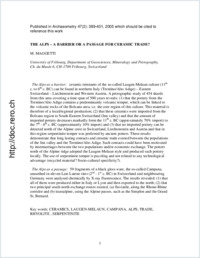The Alps - a barrier or a passage for ceramic trade ?
DOKPE
- Maggetti, Marino Mineralogy and Petrography, Department of Geosciences, University of Fribourg, Switzerland
-
22.06.2005
Published in:
- Archaeometry. - 2005, vol. 47, no. 2, p. 389-401
English
The Alps as a barrier: ceramic remnants of the so-called Laugen-Melaun culture (c. 11th to c. sixth centuries bc) can be found in the northern Italy (Trentino/Alto Adige)— eastern Switzerland—Liechtenstein and western Austria region. A petrographic study of 454 sherds from this area covering a time span of 500 years reveals the following. (1) The pottery from the Trentino/Alto Adige contains a predominantly volcanic temper, which can be linked to the volcanic rocks of the Bolzano area—in other words, to the core region of this culture. This material is therefore of a local/regional production. (2) These ceramics were imported from the Bolzano region to southeastern Switzerland (the Inn Valley) and the amount of imported pottery decreases markedly from the 11th century bc (approximately 70% imported) to the seventh to sixth centuries bc (approximately 10% imported). (3) No imported pottery can be detected north of the Alpine crest in Switzerland, Liechtenstein and Austria, and in this region serpentinite temper was preferred by ancient potters. These results demonstrate that long-lasting contacts and ceramic trade existed between the populations of the Inn Valley and the Trentino/Alto Adige. Such contacts could have been motivated by intermarriages between the two populations and/or economic exchange. The potters north of the Alpine ridge adopted the Laugen-Melaun style and produced such pottery locally. The use of serpentinite temper is puzzling and not related to any technological advantage. (Could it be recycled material? Or does it have any sociocultural specificity?) The Alps as a passage: 59 fragments of a black gloss ware, the so-called Campana, unearthed at 11 Late Latene sites (second to first centuries bc) in Switzerland and neighbouring Germany were analysed chemically by X-ray fluorescence. The results revealed: (1) that all of them were produced either in Italy or Lyon and then exported to the north; (2) that two principal south–north exchange routes existed, (a) fluviatile, along the Rhône–Rhine corridor and (b) trans-Alpine, using the Alpine passes, such as the Simplon and the Grand St Bernard.
- Faculty
- Faculté des sciences et de médecine
- Department
- Département de Géosciences
- Language
-
- English
- Classification
- Archeology
- License
- License undefined
- Identifiers
-
- RERO DOC 5111
- DOI 10.1111/j.1475-4754.2005.00209.x
- Persistent URL
- https://folia.unifr.ch/unifr/documents/299951
Statistics
Document views: 175
File downloads:
- 1_maggetti_abp.pdf: 272
